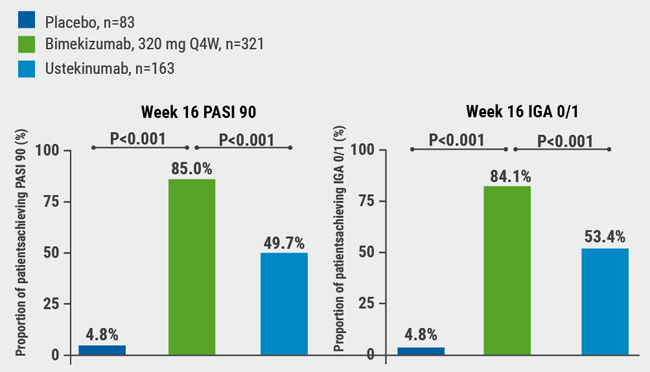Tildrakizumab is the second selective IL-23 blocker approved for treatment of patients with moderate-to-severe psoriasis. This was based on the positive results from the phase 3 reSURFACE trial that compared tildrakizumab with placebo and the TNF blocker etanercept. In this trial, tildrakizumab was well tolerated. However, elderly patients often suffer from cardiovascular comorbidity and are a particularly vulnerable group. Therefore, the current post-hoc analysis assessed the safety profile of tildrakizumab in elderly patients ≥65 years. Data for the analysis was derived from the phase 3 reSURFACE 1 (64 weeks) and reSURFACE 2 (52 weeks) trials and their long-term extension periods.
Elderly patients were analysed in 3 groups: patients who received a dose of 100 mg tildrakizumab in at least 1 part of the study, patients who received a dose of 200 mg in at least 1 part of the study, and patients who received etanercept until week 28. Severe infections were defined as any infection meeting the definition of a serious adverse event and/or infections that required intravenous antibiotics. Confirmed extended major adverse cardiovascular events (MACEs) included non-fatal myocardial infarction, non-fatal stroke, unstable angina, coronary revascularisation, resuscitated cardiac arrest, and cardiovascular deaths. For all side effects, exposure-adjusted incidence rates were calculated.
A total of 161 elderly patients were treated with tildrakizumab up to week 148 (159.5 patient years of exposure to 100 mg; 170.8 patient years to 200 mg). Exposure to etanercept was 14.7 patient years. Exposure-adjusted incidence rates of drug-related serious adverse events were 2.5, 1.76, and 6.83 in the group with the high-dose and low-dose tildrakizumab, and the etanercept group. Per 100 years of exposure, the incidence rate of severe infections was 3.76 in the low-dose tildrakizumab group, 2.34 in the high-dose tildrakizumab group, and 6.83 in the etanercept group. The exposure-adjusted incidence rates of MACEs were low in all groups (see Table), as were the exposure incidence rates of malignancies.
The authors concluded that tildrakizumab was well tolerated in patients ≥65 years of age. Drug-related serious adverse events and MACEs were rare. Reassuringly, no dose-related increase in the rate of adverse events was observed in the 200 mg tildrakizumab group.
Table: Exposure-adjusted incidence rates of extended MACE [1]
 Data are n, events per 100 patient-years. ETN, etanercept; MACE, major adverse cardiovascular event; TIL, tildrakizumab.
Data are n, events per 100 patient-years. ETN, etanercept; MACE, major adverse cardiovascular event; TIL, tildrakizumab.- Van de Kerkhof PC, et al. P13632, AAD Virtual Meeting Experience, 12-14 June 2020.
Posted on
Previous Article
« Spironolactone safe for androgenetic alopecia in cancer survivors Next Article
EAU 2020 Highlights Podcast »
« Spironolactone safe for androgenetic alopecia in cancer survivors Next Article
EAU 2020 Highlights Podcast »
Table of Contents: AAD 2020
Featured articles
Late-Breaking Abstracts
IL-17A and IL-17F blockade remarkably effective in psoriasis
Good response and pruritus reduction in AD with novel selective JAK1 inhibitor
Novel IL-23 blocker risankizumab highly effective and tolerable in psoriasis
Tape stripping – a painless way to distinguish AD and psoriasis?
IL-4/IL-13 blocker dupilumab effective in children with severe AD
Pembrolizumab leads to higher toxicity risk in obese melanoma patients
Can gene expression help to pick the right biologic to treat psoriasis in cancer patients?
Omalizumab for cancer-induced dermatoses
Psoriasis – What Is Hot?
Psoriasis therapy for children and pregnancies
Biologic psoriasis treatment to lower cardiovascular risk?
Systemic Therapies for Dermatologists
How to manage cutaneous side effects of immunotherapy
Cannabinoids: a future role in dermatology?
Hidradenitis Suppurativa/Acne Inversa
Biologics in HS – a growing armamentarium
Pearls of the Posters
Selective IL-23 blocker safe in elderly psoriasis patients
Spironolactone safe for androgenetic alopecia in cancer survivors
Baricitinib beneficial in head and neck AD
ECLIPSE trial: skin clearance independent of PsA status at baseline
Related Articles

August 6, 2020
IL-17A and IL-17F blockade remarkably effective in psoriasis
© 2024 Medicom Medical Publishers. All rights reserved. Terms and Conditions | Privacy Policy

